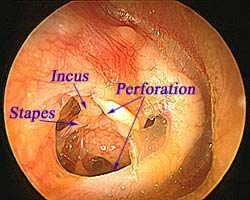What is a perforated eardrum?
 A perforated eardrum means there is a hole in the eardrum, which may have been caused by infection or injury. Quite often a hole in the eardrum may heal itself. Sometimes it does not cause any problems. However it may cause recurrent infections with a discharge from the ear. If you have an infection you should avoid getting water in the ear. If the hole is large then you may experience some hearing loss. A hole in the eardrum can be identified by an ENT specialist using an instrument called an ‘auriscope'.
A perforated eardrum means there is a hole in the eardrum, which may have been caused by infection or injury. Quite often a hole in the eardrum may heal itself. Sometimes it does not cause any problems. However it may cause recurrent infections with a discharge from the ear. If you have an infection you should avoid getting water in the ear. If the hole is large then you may experience some hearing loss. A hole in the eardrum can be identified by an ENT specialist using an instrument called an ‘auriscope'.
Surgery to repair the perforation
An operation to repair the perforation is called a 'myringoplasty'. The benefits of closing a perforation include prevention of water entering the middle ear, which could cause ear infection. Repairing the hole means that you should get fewer ear infections. It may result in improved hearing, but repairing the eardrum alone seldom leads to great improvement in hearing.
If the hole in the eardrum has only just occurred, no treatment may be required. You should discuss with your surgeon whether to wait and see, or have surgery now.
You may change your mind about the operation at any time, and signing a consent form does not mean that you have to have the operation. If you would like to have a second opinion about the treatment, you can ask your specialist. He or she will not mind arranging this for you. You may wish to ask your own GP to arrange a second opinion with another specialist.
The myringoplasty operation
The operation is almost always done under general anaesthetic. A cut is made behind the ear or above the ear opening. Occasionally, your surgeon may need to widen the ear canal with a drill to get to the perforation. The material used to patch the eardrum is taken from under the skin. This eardrum 'graft' is placed against the eardrum. Dressings are placed in the ear canal. You may have an external dressing and a head bandage for a few hours. The operation can successfully close a small hole nine times out of ten. The success rate is not quite so good if the hole is large.
Possible complications
There are some risks that you must be aware of before giving consent to this treatment. These potential complications are rare. You should consult your surgeon about the likelihood of problems in your case.
- Taste disturbance: The taste nerve runs close to the eardrum and may occasionally be damaged. This can cause an abnormal taste on one side of the tongue. This is usually temporary but occasionally it can be permanent.
- Dizziness: Dizziness is common for a few hours following surgery. On rare occasions, dizziness is prolonged.
- Hearing loss: In a very small number of patients, severe deafness can happen if the inner ear is damaged.
- Tinnitus: Sometimes the patient may notice noise in the ear, in particular if the hearing loss worsens.
- Facial Paralysis: The nerve for the muscle of the face runs through the ear. Therefore, there is a slight chance of a facial paralysis. The facial paralysis affects the movement of the facial muscles for closing of the eye, making a smile and raising the forehead. The paralysis could be partial or complete. It may occur immediately after surgery or have a delayed onset. Recovery can be complete or partial.
- Reaction to ear dressings: Occasionally the ear may develop an allergic reaction to the dressings in the ear canal. If this happens, the pinna (outer ear) may become swollen and red. You should consult your surgeon so that he can remove the dressing from your ear. The allergic reaction should settle down after a few days.
Disclaimer
The details in this section are for general information only. Always check with your own surgeon.